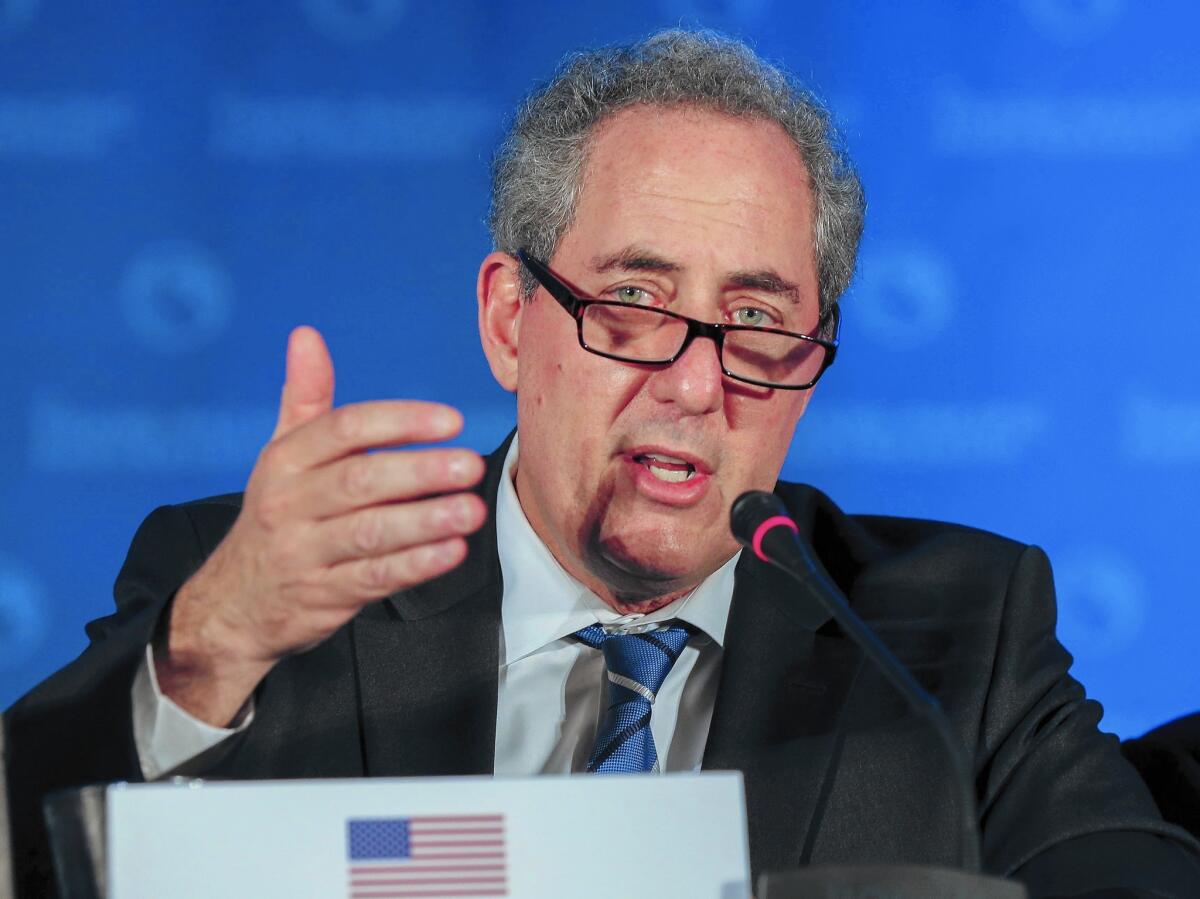‘This isn’t NAFTA,’ U.S. trade representative says about Trans-Pacific Partnership

- Share via
After years of negotiations, the United States and 11 other Pacific Rim countries wrapped up a sweeping trade agreement in October that supporters say will eliminate obstacles such as tariffs and set standards for doing business in 40% of the global economy.
The deal has faced tough opposition in Congress — particularly among Democrats, who believe that past accords such as the North American Free Trade Agreement have sacrificed U.S. jobs to foreign competition.
After months of wrangling and intense lobbying from the Obama administration, Congress this year gave the administration so-called fast track authority to negotiate the final details of the Trans-Pacific Partnership with the other countries — Japan, Canada, Australia, Mexico, Malaysia, Singapore, Chile, Peru, New Zealand, Vietnam and Brunei.
The final deal still faces a yes-or-no vote from Congress, which cannot make amendments to the agreement, in the midst of a contentious 2016 election season. On the campaign trail so far, Democratic hopefuls Bernie Sanders and Hillary Clinton have opposed the deal, as well as Republican candidate Donald Trump — although for different reasons.
The Times sat down with U.S. Trade Representative Michael Froman, the Obama administration’s chief negotiator for the trade agreement. Below is an edited version of that interview.
You’ve had to travel around the world to sell this other countries and it has faced tight votes in Congress. Can you break down the importance of an agreement like this and why in this part of the world?
The Asia-Pacific region is going to be home to an estimated 3.2 billion middle-class consumers by 2030 and it’s a region that’s very much in flux. We think it’s important that the U.S. play a leading role in helping to define the rules of the road for the region and not leave that to others.
We take in imports from all over the world now. But we face these barriers which create an unfair situation for our workers and for our companies. What we’ve tried to do is eliminate barriers to these other markets and level the playing field by raising their standards. That creates new opportunities for us to increase our exports.
How do you think California, as distinct from other parts of the country, will be affected by this deal?
California is such an immense and diversified economy that it stands to benefit across the board: manufacturing, services, agriculture. There’s a 15% tariff on headphones made in the U.S. That’ll go to zero.
Some of these markets like Malaysia and Vietnam have emerging middle classes. The first thing a middle-class person wants is more protein in their diet, better nutrition and safe food. Having a “grown in America” product is a great brand in this region, whether that’s beef, pork, poultry, dairy products, fruits and vegetables, nuts or wine. All of those are produced in abundance in California.
Why the focus on exports and jobs driven by exports?
Export-related firms tend to hire more, pay more and be more durable during times of economic uncertainty because they can diversify their markets. There are a range of economic studies out there that say, on average, export-related jobs pay up to 18% more than non-export-related jobs in the same sector.
What would you say to the criticism that past trade agreements have opened the door for moving production jobs overseas?
I disagree with that. Take Vietnam: It has 90 million people, it’s a fast-growing economy, it has an emerging middle class.
We have two choices: One, we can lower their barriers to our exports, which allows us to continue to produce here, produce more here and sell in Vietnam; or — if we let them continue to have high barriers — companies will have every incentive to move there to get past the barriers to be able to serve that market. Our preference is to lower other countries’ barriers so that people have a reason to produce in the United States.
Throughout the debate over TPP, there has been a constant comparison to the North American Free Trade Agreement. Some argue that NAFTA cost the U.S. hundreds of thousands of jobs, others say it caused job gains. Either way, are there lessons learned from NAFTA in this agreement?
Whatever your position is on NAFTA, this isn’t NAFTA. In the intervening 23 years, we have looked at our experience and we have built on it. When Sen. Obama was running for president, he said we can’t afford to have labor and environmental obligations be treated in side agreements that are not fully enforceable. So with TPP, one of its fundamental elements is that trade and environmental obligations are first of all stronger than ever before, clearer than ever before, fully enforceable and at the center of the trade agreement.
Enforcement has been a huge point of criticism for labor and environmental groups. What would you say to critics who question whether this agreement will have the teeth to enforce standards?
It’s got real teeth. Not only the labor and environmental provisions but the intellectual property provisions, the state-owned enterprise provisions, the digital economy provisions. These are tighter provisions than we’ve had in previous trade agreements. It lays out specific timetables by which the dispute settlement has to take place.
It avoids situations of some of our past trade agreements where one party could slow down or prevent the dispute settlement process from reaching a conclusion. At the end of the day, if a party doesn’t change their policies, it allows us to impose trade sanctions on them.
Could the U.S. do that under NAFTA?
Not on trade and environment.
Even some economists who support this trade agreement have argued that, in 10 to 15 years, there may only be a modest increase in the number of U.S. jobs. Do you expect a huge boost in the U.S. economy and a big increase in the number of jobs?
Trade agreements are not a panacea. They’re part of a larger economic strategy where you need to invest in infrastructure, you need to invest in education and all the elements that help make the American workforce competitive. But if the debate is about whether trade agreements will create more jobs or only create better jobs, I think it’s a great debate to have.
More to Read
Inside the business of entertainment
The Wide Shot brings you news, analysis and insights on everything from streaming wars to production — and what it all means for the future.
You may occasionally receive promotional content from the Los Angeles Times.











